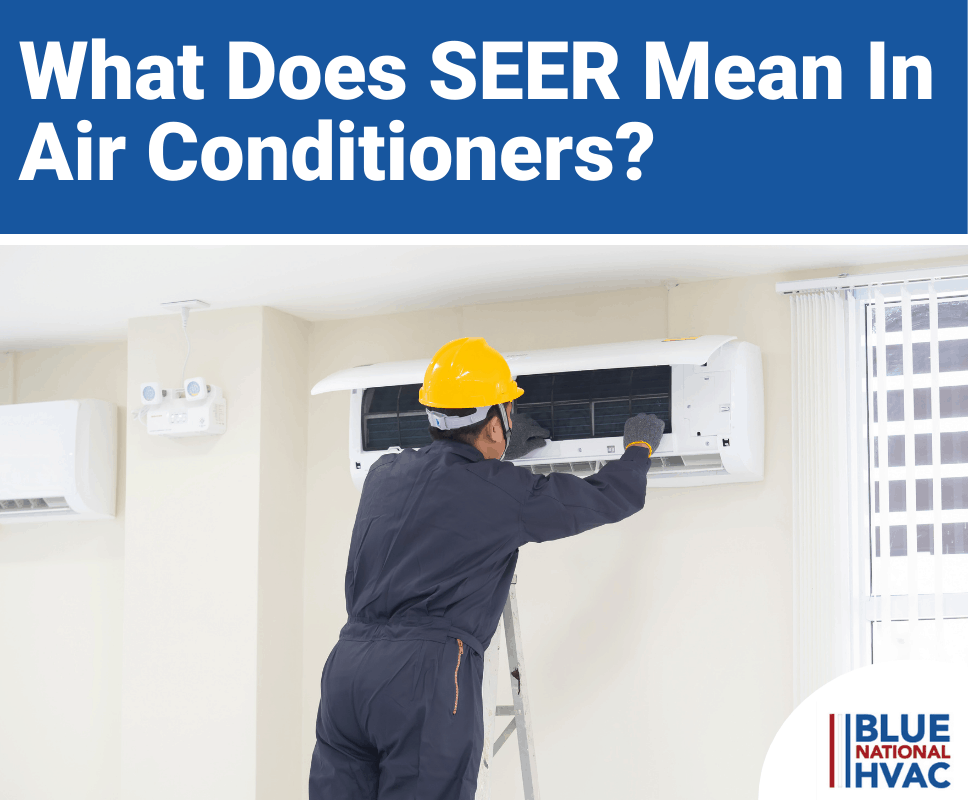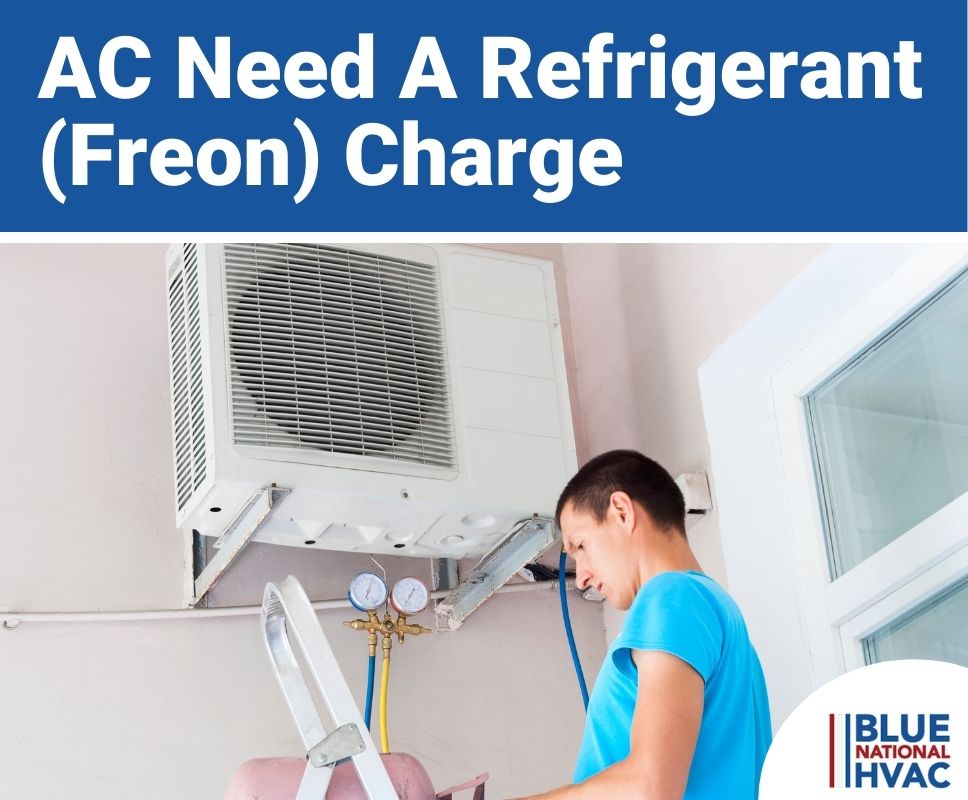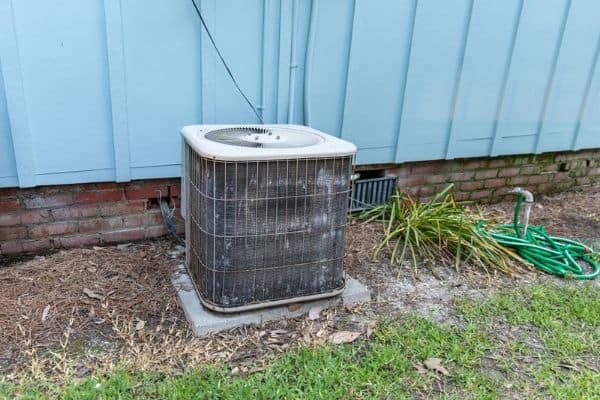And much more!
So, if you’re looking for information about SEER ratings of air conditioners, keep reading our detailed guide below to get answers to all of your questions!
What Does SEER Mean in Air Conditioners?
If you’ve been looking at air conditioning units, you’ve probably noticed a description that says “14 SEER” or something similar. SEER stands for Seasonal Energy Efficiency Ratio and is a specification all air conditioners carry.
The SEER efficiency rating of an HVAC system relates directly to how efficiently it cools your home. If the air conditioning system has a high SEER rating, it’s more energy-efficient, consumes less energy, and costs less money to operate. Higher SEER units mean better efficiency.
Understanding SEER ratings before you pick a new AC system will help you make the best decision on your new equipment.
What Do You Need To Know About SEER Rating?
The SEER rating is a ratio determined by finding the annual cooling output of the AC unit and the amount of electricity it uses during that period. The manufacturer determines the SEER rating of an AC system through extensive calculations and real-world testing.
You can use the SEER rating of an AC conditioner to determine the amount of energy it will use!
How to Use SEER to Estimate Power Usage and Energy Costs
Here’s how to calculate the amount of energy your AC unit will use:
First, you’ll need to find the air conditioner’s cooling output, which is measured in British thermal units per hour (BTU/h). Then you multiply that by the hours it’s used each day and the number of days used per year to find the BTUs used per year.
For example, if the AC unit’s cooling output is 5,000 BTU/h, it’s used 150 days per year, and 12 hours each day, the BTUs are found with the below equation:
5,000 BTU/h 150 days 12 hours/day = 9,000,000 BTUs per year
If you want to estimate your energy usage per year, use the below equation by converting the BTUs per year number to watt-hours (Wh) per year:
9,000,000 BTUs per year 15 BTU/Wh = 600,000 Wh per year
To estimate the annual power usage divide the cooling output of the AC unit by the SEER rating (the SEER rating is 14 in this example):
5,000 BTU/h 14 SEER = 357 watts or 0.357 kilowatts (kW)
Now that you have the number of kilowatts your AC unit uses, you can multiply that by your utility company’s electricity costs. So, if your local energy costs are $0.22 per kWh, multiplying that by 0.357 kW yields $0.08 per hour!
SEER vs. EER and COP
While looking at SEER ratings of air conditioning units, you will likely come across two other important HVAC terms- COP and EER.
- EER is the Energy Efficiency Ratio
- COP is the Coefficient of Performance
The EER differs from SEER in that EER is a measurement of efficiency at a single outdoor temperature of 95°F (35°C). EER is a great way to compare AC units of different styles like ductless mini-splits against window AC or central air systems.
Higher EER ratings mean better efficiency, just like SEER ratings.
COP is mainly applied to heat pumps. It is also a measure of efficiency. However, it is only applied to the heating function of heat pumps. Since heat pumps can provide cooling and heating, you will probably find both a SEER and COP rating on a heat pump.
COP is the amount of heat energy a heat pump produces divided by the electrical energy it uses. Like SEER and EER, a higher number is better and will reduce your energy bills more.
State SEER Rating Requirements
Before the 1990s, there weren’t any industry standards to measure HVAC equipment’s efficiency. In 1992, the US government passed legislation that established minimum SEER ratings- at that time, SEER ratings of 9 were most common.
With the US Energy Policy Act of 2005, Congress updated the minimum standard SEER rating to 13.
Today, all US states have a minimum SEER rating as well. The rating requirements mean that new AC units must meet the minimum to be sold. Don’t worry, though, it shouldn’t even be possible to purchase an air conditioner with too low of a SEER rating.
However, if you have an old air conditioner predating 2005, you can improve your efficiency instantly if you upgrade to a new AC system since the SEER ratings on them are much higher now.
Why Do SEER Ratings Matter?
SEER ratings matter because they demonstrate the energy efficiencies of air conditioning systems and provide a great way to compare different brands and models. Without them, there would be no easy way to compare energy consumptions and their costs to operate.
With the growing environmental concerns of climate change, SEER is an important benchmark on air conditioners to ensure they are not using an extreme amount of energy to operate. They also provide a method of efficiency oversight for the US Department of Energy, which mandates the minimum SEER ratings of air conditioners.
What Are Good SEER Ratings For Air Conditioners?
SEER ratings are now much higher than they were 20 years ago. With US and state requirements of 13 and 14 SEER, that will be the minimum rating you will find on new AC systems.
You will be able to find AC systems with ratings from 13-22 SEER. The SEER rating of your system is the maximum rating it can possibly achieve. Realistically, it might operate at a lower SEER due to variables like the size of your home, quality of ductwork, shade, climate zone, and more.
Hinger SEER-rated AC units usually have extra components to work more efficiently. They will commonly have a variable speed blower and a 2-stage or variable speed compressor.
Since air conditioning systems with higher SEER ratings generally cost more upfront but save you money on operating costs, it may be hard to choose the best SEER rating for your home. This is why it’s likely best to reach out to one of our seasoned HVAC professionals to have them answer any questions and help you choose the right option for you.
14 SEER
AC units with a 14 SEER rating are not only the most inexpensive; they are the most common type amongst homeowners too. A 14 SEER unit typically has a single-speed blower and a single-stage compressor.
They provide adequate cooling and comfort to your home and sometimes have more hot/cold spots and more humidity variances than more efficient systems.
Compared to higher SEER ratings, 14 SEER units can only run in 2 modes – off and on – and cannot vary their speed. They will turn off and on more often than variable speed AC units and use more energy.
15 SEER
Air conditioners with a 15 SEER rating offer a bit higher efficiency than their 14 SEER counterparts. Their upfront costs are not much higher than a 14 SEER unit and provide almost negligible energy cost savings.
Starting in 2023, the US will implement new standards on minimum SEER ratings. They will require all new residential air conditioners to be 15 SEER rating or higher in the southern states and 14 SEER or higher in the northern states.
16 SEER Ratings and Higher
As you might have guessed- 16 SEER and up-rated AC units have an even higher efficiency than 14 and 15 SEER devices. In general, air conditioners with 16 SEER and higher ratings include more sophisticated components that allow them to run more efficiently.
Most of them include variable speed blowers, 2-stage compressors, and even variable speed compressors for units. Typically 17 SEER, 18 SEER, etc., have a variable speed compressor.
AC units with higher SEER ratings provide better comfort to your home. They run for more extended periods, around 80% capacity. Since they run longer, they use less energy (starting and stopping many times using much more power).
Running longer also means your air is better conditioned, leading to fewer cold/hot spots and better humidity levels throughout the whole house.
Additional Air Conditioner Aspects to Consider
The SEER rating of the air conditioner should not be the only factor you use in deciding on a new air conditioner purchase. You should also consider other essential aspects, including:
- Your climate zone
- Length of the cooling season in your region
- The natural shade of your home
- The size (cooling capacity) of the AC unit
- Quality, brand, and warranty
- Ability to work with a smart thermostat
- Your budget
As you can see, there are many aspects you should consider. However, the SEER rating is one of the more important ones. If there are too many factors for you to make the decisions, a local HVAC dealer should be able to assist you.
How Much Does SEER Ratings Cost?
Comparing the cost of efficient air conditioners on SEER rating alone is tricky because other aspects change the price. So, keep this in mind when comparing various brands and models with the same SEER rating.
A good rule of them is to compare AC units with the same tonnage but different SEER ratings.
Here are the average prices for a 3-ton central air conditioner with different SEER ratings:
- 14 SEER: $1,000 to $1,400
- 15 SEER: $1,200 to $1,800
- 16 SEER: $1,300 to $2,000
- 17 SEER: $3,000 to $4,500
- 18 SEER: $3,500 to $4,800
What Should You Look For In An HVAC Specialist?
If you need assistance in upgrading to the best SEER rating for your new air conditioner, reach out to one of our HVAC professionals. They can assess your home and do a Manual J calculation to recommend the best size AC Unit.
They can also recommend various SEER ratings to you and compare the upfront costs versus the energy savings they provide.









